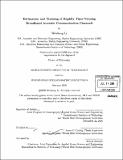| dc.contributor.advisor | James G. Preisig. | en_US |
| dc.contributor.author | Li, Weichang, 1972- | en_US |
| dc.contributor.other | Woods Hole Oceanographic Institution. | en_US |
| dc.date.accessioned | 2007-10-19T20:30:52Z | |
| dc.date.available | 2007-10-19T20:30:52Z | |
| dc.date.copyright | 2006 | en_US |
| dc.date.issued | 2006 | en_US |
| dc.identifier.uri | http://hdl.handle.net/1721.1/39205 | |
| dc.description | Thesis (Ph. D.)--Joint Program in Oceanography/Applied Ocean Science and Engineering (Massachusetts Institute of Technology, Dept. of Mechanical Engineering; and the Woods Hole Oceanographic Institution), 2006. | en_US |
| dc.description | Includes bibliographical references (p. 197-206). | en_US |
| dc.description.abstract | This thesis develops methods for estimating wideband shallow-water acoustic communication channels. The very shallow water wideband channel has three distinct features: large dimension caused by extensive delay spread; limited number of degrees of freedom (DOF) due to resolvable paths and inter-path correlations; and rapid fluctuations induced by scattering from the moving sea surface. Traditional LS estimation techniques often fail to reconcile the rapid fluctuations with the large dimensionality. Subspace based approaches with DOF reduction are confronted with unstable subspace structure subject to significant changes over a short period of time. Based on state-space channel modeling, the first part of this thesis develops algorithms that jointly estimate the channel as well as its dynamics. Algorithms based on the Extended Kalman Filter (EKF) and the Expectation Maximization (EM) approach respectively are developed. | en_US |
| dc.description.abstract | (cont.) Analysis shows conceptual parallels, including an identical second-order innovation form shared by the EKF modification and the suboptimal EM, and the shared issue of parameter identifiability due to channel structure, reflected as parameter unobservability in EKF and insufficient excitation in EM. Modifications of both algorithms, including a two-model based EKF and a subspace EM algorithm which selectively track dominant taps and reduce prediction error, are proposed to overcome the identifiability issue. The second part of the thesis develops algorithms that explicitly find the sparse estimate of the delay-Doppler spread function. The study contributes to a better understanding of the channel physical constraints on algorithm design and potential performance improvement. It may also be generalized to other applications where dimensionality and variability collide. | en_US |
| dc.description.statementofresponsibility | by Weichang Li. | en_US |
| dc.format.extent | 206 p. | en_US |
| dc.language.iso | eng | en_US |
| dc.publisher | Massachusetts Institute of Technology | en_US |
| dc.rights | M.I.T. theses are protected by copyright. They may be viewed from this source for any purpose, but reproduction or distribution in any format is prohibited without written permission. See provided URL for inquiries about permission. | en_US |
| dc.rights.uri | http://dspace.mit.edu/handle/1721.1/7582 | |
| dc.subject | /Woods Hole Oceanographic Institution. Joint Program in Oceanography/Applied Ocean Science and Engineering. | en_US |
| dc.subject | Mechanical Engineering. | en_US |
| dc.subject | Woods Hole Oceanographic Institution. | en_US |
| dc.subject.lcsh | Underwater acoustics Mathematical models | en_US |
| dc.title | Estimation and tracking of rapidly time-varying broadband acoustic communication channels | en_US |
| dc.type | Thesis | en_US |
| dc.description.degree | Ph.D. | en_US |
| dc.contributor.department | Joint Program in Oceanography/Applied Ocean Science and Engineering | en_US |
| dc.contributor.department | Woods Hole Oceanographic Institution | en_US |
| dc.contributor.department | Massachusetts Institute of Technology. Department of Mechanical Engineering | |
| dc.identifier.oclc | 76881852 | en_US |
